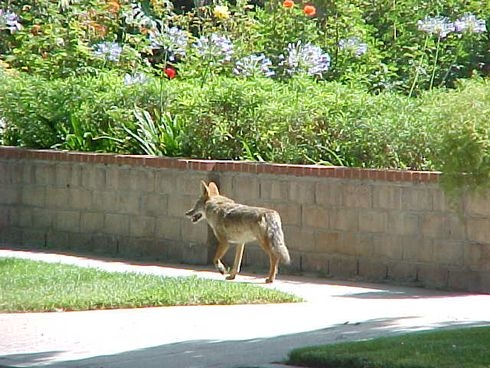Saturday evening after Thanksgiving I looked out the window to see what tripped one of the motion sensor lights outside my home. What I saw was what looked like a large gray fox strolling across my front yard. But after a little research, I determined it was not a fox, but a coyote (Cannis latrans)based upon its shorter tail.
I live in a rural area and over the years I’ve often heard coyotes howling at night in the distance, but this was the first time, and hopefully the last, I saw one by the house. Coyotes are not uncommon in Solano county. Highly adaptable, they are native to Western North America and over the years their numbers have increased and so has their geographic coverage. They often wander into suburban areas and will even take up residence in them if there is sufficient food and water, and if they have lost their fear of humans.
Coyotes are members of the dog family and are bigger than foxes and smaller than wolves. They have a bushy black tipped tail. (Foxes have similar looking tails but unlike coyotes, their tails are nearly the length of their body). Photos of a coyote and a fox can be found on the web at http://foxsurvey.ucdavis.edu/id.html.
Because coyotes are so adaptable, they can survive on a variety of different food sources. Rodents and rabbits are their usual food source. As predators, they can and will also attack birds, small domestic animals and livestock. But if needed, they will also consume insects like grasshoppers and grubs in compost piles, fruits, berries and seeds.
Home landscape plants having fruits and seeds preferred by coyotes include:
Avocado (Persea americana)
Date Palm (Phoenix dactylifera)
Elderberry (Sambucus spp.)
Fig (Ficus carica)
Jujube (Ziziphus jujube)
Loquat (Eriobotrya japonica)
Lychee (Litchi chinensis)
Strawberry bush (Euonymus americanus)
Strawberry tree (Arbutus unedo)
Sugar bush (Rhus ovata)
Besides attacking and killing small animals, coyotes have also been known to chew drip irrigation lines. For more information on identifying damage caused by coyotes, and what to do if confronted by one, check out the coyote information on the UC website at http://www.ipm.ucdavis.edu/PMG/PESTNOTES/pn74135.html.
Since the coyote was strolling away from the general area of a large planter I had watered earlier in the day, I’m guessing it may have been drinking the excess water from the saucer under the planter. Since November has been such a dry month and the creek beds are dry, I suspect it went in search of water. So I emptied the excess water from the saucer and checked to make sure there was no other water in saucers at the bottom of planters in my yard. Hopefully this will discourage the coyote from ever returning again.
Attached Images:
